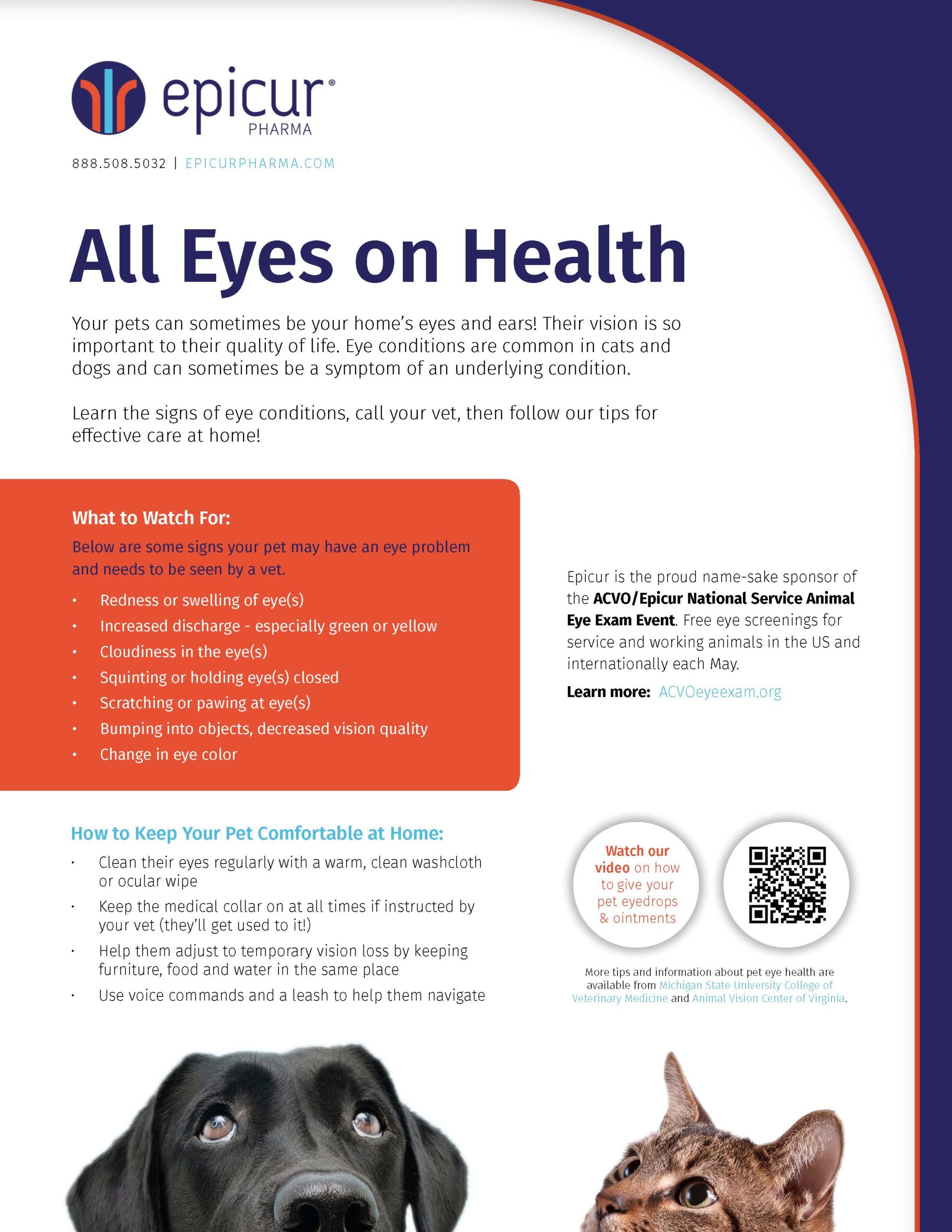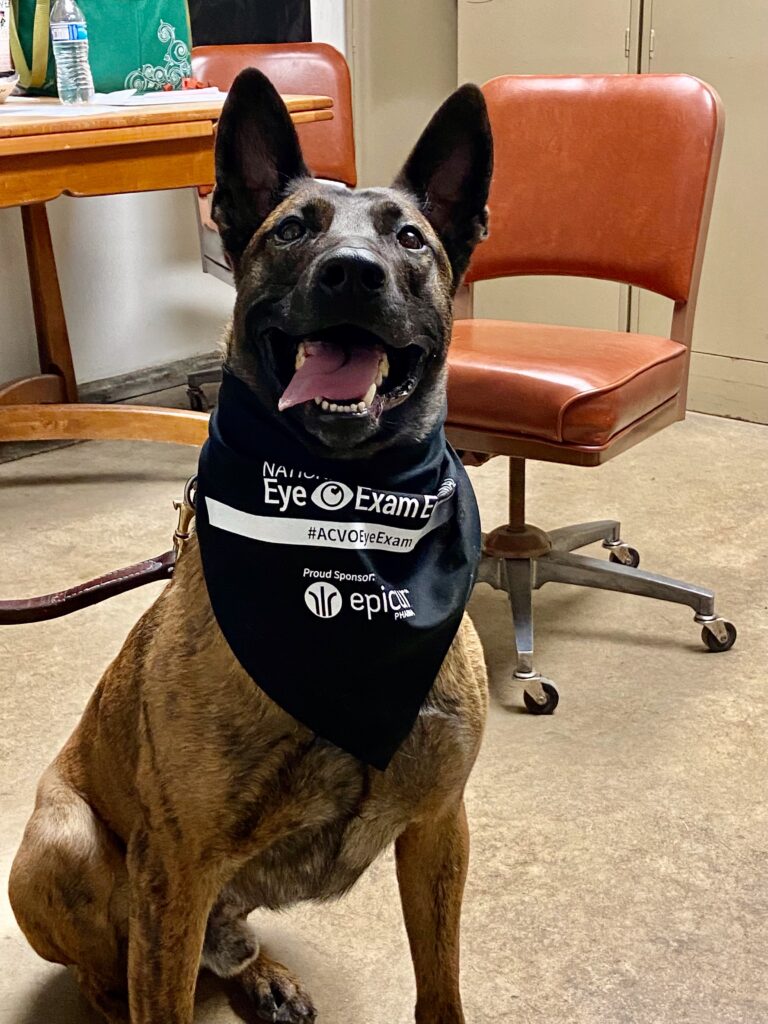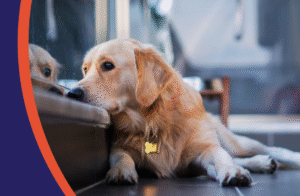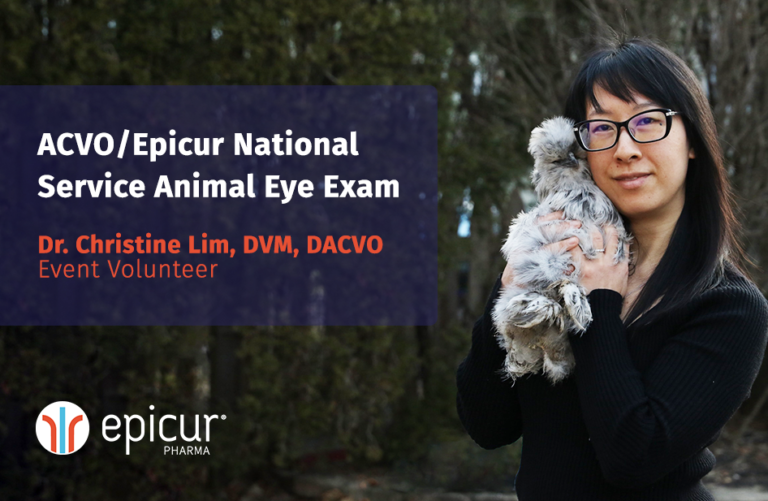After a two-year break due to the COVID pandemic, the ACVO/Epicur National Service Animal Eye Exam Event is back this May! As the namesake sponsor of the event, this is one of the Epicur team’s favorite events. It truly shows the compassion and heart of the veterinary community with veterinary ophthalmologists and their staff volunteering their time the entire month to give free eye exams to service animals. We’ve had the privilege of being at some of the clinics during these exams to see firsthand how much this event means to the pet, the owner, and the veterinary clinics.
Dr. Christine Lim, DVM, DACVO is an ophthalmologist at Eye Care for Animals and has volunteered for the ACVO/Epicur event for years. We recently sat down with her to learn more about why she chose veterinary ophthalmology and what this philanthropic event means to her.
Thanks for sharing your perspective on the event with us, Dr. Lim! Can you tell us more about your background and how you ended up in the veterinary field?
Like most kids, I loved animals. I did pet sitting and worked at various clinics and the Humane Society when I was younger. That led me to veterinary medicine. During school I developed an interest in ophthalmology, probably because it was both surgery and medicine rather than just one or the other, I got to do both.
After vet school in Ontario, I did a one-year internship in small animal medicine and surgery. Then I did one year in small animal general practice where I also spent time with an ophthalmologist on my days off to see how an ophthalmology practice worked. Following that, I went to UC Davis for a three-year residency in ophthalmology.
My first job as an ophthalmologist was in Saskatchewan at the university for a couple of years before joining the faculty in Minnesota for about seven years. Then we moved to Chicago, which is when I joined Eye Care for Animals.
What is it that’s so special about the ophthalmology specialty to you?
I think Ophthalmology is very cool because you can take someone who is blind and scared and give them their vision back; you’re helping them enjoy life again. Even in the sad cases where they’re permanently blind and they’re in pain, you can at least take away the pain and make them feel better.
I think the surgeries are very cool and a nice challenge. A lot of them are quite intricate and artistic, which makes them interesting. But it’s also a mix of surgery and medicine. So, I think it’s just a nice specialty because you get to do a lot of different things with different species. We do eyes so it doesn’t matter what animal you’re working with; you get a lot of variety.
Help your pet owners stay up to date with their pet’s eye health!
Check out our animal eye health page, which includes our new handout—Eyes on Health!

Do you specialize in a particular surgery or area of ophthalmology?
Veterinary ophthalmology specialties are less developed than they are in human physician medicine where you have retinal specialists, corneal specialists, etc. There are several veterinary retinal specialists in North America.
Personally, I like all ophthalmology surgeries because I like the mix, but I do enjoy intraocular surgery a little more than the others. It’s very intricate and more of a challenge. The area you’re working on is very small and all right in front of you. It was very hard for me as a general practitioner to enjoy things like abdominal surgery because it was less intricate and clean.
Ophthalmology definitely sounds like an interesting area of veterinary medicine! Let’s talk about the ACVO/Epicur National Service Animal Eye Exam Event – how long have you been participating?
For more than a decade – I’ve been volunteering since I started as an ophthalmologist in 2008. The clinic I was practicing in at the time would sign up, so that’s how I got into it.
There was a lot of promotion around it and it’s a fun event to do. I think everyone in ophthalmology is interested and willing to do it.
And your clinic does the exams for the police dogs, correct? How did you get connected with such an important group of service dogs?
Most practices I’ve worked at have police dogs as patients. For Chicago that was the case before I joined the practice. Working with them for the service animal event grew out of those connections.
For the event this year, one of my vet techs and I are going to drive down to the department’s canine training facility to do a bunch of exams back-to-back to make things easier for them this year.


Roy, a Chicago Police K-9, with Dr. Lim after completing his exam this year!
Are there any unique stories that you have from the event? Or a favorite animal that you’ve examined?
I think a lot of times it’s not just about the pet or the animal that you’re seeing. It’s just the whole relationship with the owner and how special their service animal is to them. It’s really nice to see the bond between the person and the service animal, a dog in most of these cases, and how much these dogs help these people in life.
Have any of the exams ever resulted in a big medical catch or impact on the service animal?
We did have one police dog, not in Chicago but somewhere else, and it turned out he was nearly blind from hereditary retinal degeneration. The police department and handler didn’t know that. Unfortunately, there was no way to save his sight or change the outcome but knowing that information is important because it impacts the dog’s ability to do its job.
Besides dogs, what other types of animals have you seen?
For the event, it’s mostly dogs. There are many service animals that aren’t dogs, but that’s the most common one I see during May exams.
Outside of the event, I think any of the zoo animals must be the most interesting. There was a Galapagos tortoise that was really happy to see me the first time but on the second visit she remembered why I was there, so she pulled her head in as soon as I walked into her area.
It’s been years, but I did cataract surgery on a bald eagle once. I used to see a lot of raptors when I was on faculty in Minnesota. Weekly we did eye exams at their raptor center where they treated injured raptors. That was a lot of fun. During zoo visits, I’ve had the opportunity to examine a whole bunch of different species.
That sounds like it makes for interesting workdays! Before we wrap up, what would you say the ACVO/Epicur Service Animal Eye Exam Event means to you and the impact that it has?
I think it’s just nice to be reminded that there is something special and good in what you do, that you can help people. It’s special in your job to be able to do things that you can see are making people happy. But not just that, you get to see how it can make a difference.
It really is a fun event and most of us like participating in it because we get something out of it. We get to see the impact. And after two years of not having it, I’m really looking forward to it!
Thanks, Dr. Lim! Check back in for more highlights from the ACVO/Epicur National Service Animal Eye Exam Event!
Check out some of our recent posts or visit our blog for the complete list:

Updates on the Treatment of Equine Gastric Disease
January 8 | 4 p.m. ET RACE-Approved CE Credit Hours: 1Free to attend An upcoming webinar will highlight recent developments in the management of both squamous and glandular gastric disease, reviewing recent publications in the context of existing knowledge. Attendees will gain an understanding of the limitations of oral proton pump inhibitors and explore advances in newer generation PPIs, including extended-release injectable omeprazole. The session will also cover the published evidence supporting a range of treatment options for gastric disease. Save My Seat

Smooth Delivery: A Novel Extended-Release Buprenorphine in Laboratory Animals
December 10 | 7 p.m. ET RACE-Approved CE Credit Hours: 1Free to attend Explore the importance of pain management in laboratory rodents, focusing on a new extended-release buprenorphine injectable. Attendees will learn how its low viscosity improves administration, reduces handler strain, and enhances animal comfort. The session will also cover best practices for administration and monitoring. Save My Seat

Easing Pet Anxiety and Empowering Owners
Imagine a dog trembling at the sound of thunder or a cat hiding for hours after a trip to the vet. These aren’t just quirks, they’re signs of anxiety, a condition that affects countless pets and often leaves their owners feeling helpless. Whether it’s separation stress, loud noises, or unfamiliar environments, anxiety can disrupt a pet’s well-being and strain the bond between animal and human. Advancing the standard of care for animals doesn’t just happen in veterinary practices; informed ownership leads to better care all around. By getting to the root of pet anxiety and educating on effective responses, veterinary professionals can empower and ease pet owners and their pets alike. Getting to the root of a pet’s anxiety Anxiety manifests in humans through rapid heart rate, rapid breathing, sweating, trembling, feeling weak, restlessness, nervousness, paranoia, and more. Animals are no different. Pets experience anxiety from the anticipation of a fear-inducing stimulus. It can be situational or related to specific triggers such as being left alone, a visit to the vet, or fireworks during holidays. The most common forms of pet anxiety are: Separation Anxiety – when pets get nervous or uncomfortable when they are alone or separated from their family. Fear-Related Anxiety – stems from several factors, including early life experiences, environmental influences, or even genetics. Examples of triggers are loud noises, specific situations, and unfamiliar people/animals. Age-Related Anxiety – often associated with older dogs with cognitive dysfunction syndrome (CDS), where memory, learning, perception, and awareness can decline and lead to confusion/anxiety. Helping pet owners understand the root of their pets’ anxiety can also help them understand the symptoms can show in many different forms, including but not limited to: Destructive Behavior Restlessness Hiding Loss of Appetite Clinginess Excessive Vocalization Urination or Defecation Aggression Empowering pet owners through education Pet anxiety doesn’t just affect the animal; it deeply impacts the owner’s emotional well-being and confidence in caregiving. When owners understand the signs of anxiety and the science behind it, they’re better equipped to respond with empathy and effectiveness. Education can foster trust between veterinarians and pet parents, creating a collaborative approach to care. It also helps demystify behaviors that might otherwise be misinterpreted as disobedience. For example, a dog chewing holes in the carpet when left alone can be sign of separation anxiety rather than the pet acting out. As a veterinary professional, you play a vital role in this learning process. By offering clear explanations, personalized guidance, and evidence-based resources, you empower owners to take proactive steps. This includes recognizing early warning signs, implementing calming strategies, and knowing when to seek medical support. When pet parents feel empowered, they become active participants in their pet’s healing journey, reducing stress for everyone involved—and most likely making visits to your practice much simpler in many cases! How pet owners can ease pet anxiety Managing pet anxiety requires a blend of behavioral techniques, environmental adjustments, and sometimes medical intervention. Here are some proven strategies to share with your clients: Create a Safe Space: Designate a quiet, cozy area where their pet can retreat during stressful moments. Familiar blankets, toys, and scents can help soothe them. Desensitization and Counterconditioning: Gradually expose pets to anxiety triggers in a controlled way with professional guidance from a certified behaviorist or trainer, pairing the experience with positive reinforcement. Routine and Predictability: Pets thrive on consistency. Regular feeding, walking, and play schedules can reduce uncertainty and stress. In severe cases, you may recommend anti-anxiety medications based on the short-term or long-term needs of a pet. For example, short-term medications can help pets relax when they come to your practice for a visit, making their appointment as stress-free as possible Common pet anxiety medications include: Fluoxetine – a selective serotonin reuptake inhibitor (SSRI) often used for long-term anxiety management. Trazodone – frequently prescribed for situational anxiety, such as vet visits or travel. Clomipramine – a tricyclic antidepressant used for separation anxiety. Gabapentin – often used in both dogs and cats to reduce fear and anxiety, particularly during veterinary visits. Benzodiazepines (e.g., alprazolam, diazepam, lorazepam) – short-acting medications used for acute stress events or predictable triggers such as fireworks or thunderstorms. Buspirone – sometimes prescribed, particularly in cats, for generalized anxiety. These medications help regulate mood and reduce fear responses, but they work best when paired with behavior modification techniques. It’s important to talk through all the symptoms and options with your clients to determine the right medication and dosage for each pet’s unique needs. Office-Use Medications for Your Practice & Patients Our team knows that quality and consistency are non-negotiable when it comes to pet health. That’s why we proudly manufacture gabapentin, fluoxetine, and other essential medications to FDA standards, ensuring safety and efficacy in every dose. Learn more about our veterinary medication portfolio! View our Products Stokes Pharmacy also compounds many of these other drugs for individual patient prescriptions! Pet anxiety is more than a behavioral issue. It’s a health concern that can affect the entire household. For veterinary professionals, recognizing the signs of anxiety is just the beginning. The real impact comes from guiding pet owners with clarity, empathy, and evidence-based solutions. Veterinarians are uniquely positioned to transform fear into comfort and confusion into clarity. Through thoughtful education, personalized care plans, and access to trusted medications, you empower owners to become confident caregivers. We believe that every pet deserves peace of mind and every owner deserves the tools to provide it. From manufacturing high-quality medications to supporting wellness education, we offer a variety of resources that your practice can share so you and your clients can make compassionate care a reality, together. Get more tips and resources to share with pet owners Resource Library


